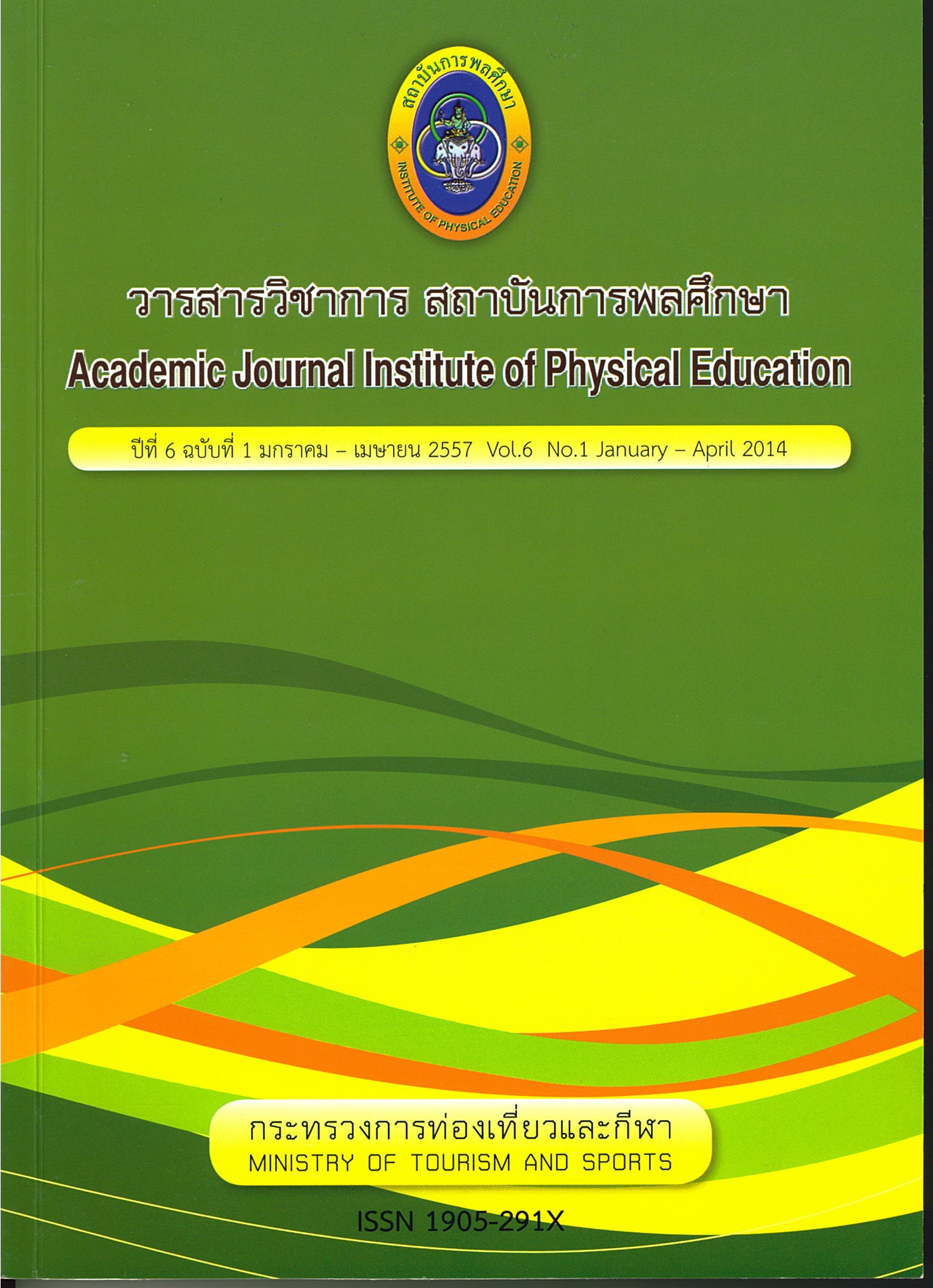Development of a Critical Thinking Process-Oriented Instructional Model for Physical Education Undergraduate Students in the Faculty of Physical Education at Institute of Physical Education
Main Article Content
Abstract
The purposes of this research were 1) to study and analyze the elements of critical thinking process of physical education undergraduate students in the Faculty of Physical Education in the Institute of Physical Education 2) to develop a critical thinking processoriented instructional model for the undergraduate students and 3) to study the effect of using a critical thinking process-oriented instructional model for the subject of physical education pedagogy towards their learning achievements, the ability of critical thinking and the satisfaction of the undergraduate students towards a critical thinking process
oriented instructional model. The research which comprised 3 phases of operation, namely; Phase 1: study and analyze the elements of critical thinking process by studying the principles, concepts, theories and related researches and documents together with the consideration of 10 experts through focus group process. The data analysis from the purposive sample group who were all 246 lecturers, out of 286 equivalent to 86.01% in the Faculty of Physical Education in the Institute of Physical Education was confirmed by confirmatory factor analysis through the analytical technique of Linear Structural Relationship by LISREL VERSION 9.10 Invoice Number DP-13-031113-9451) Phase 2: this phase was composed of 2 stages of developing instructional model, namely 1) stage of synthesizing instructional model 2) stage of developing and finding out the effectiveness of instructional model and Phase 3: study the effect of critical thinking process-oriented instructional model through one group time series experimental method. The sample group was 40 undergraduate students studying in the third-year Bachelor's Degree in the Faculty of Physical Education in the Institute of Physical Education. The sam by using volunteer selection technique, participating in the experimentation for 10 weeks for data analysis. Mean, standard deviation and repeated measure MANOVA were used.
The results of this study were as follows:
- The elements of critical thinking process-oriented for physical education undergraduate students in the Faculty of Physical Education in the Institute Education were consisted of 8 elements included 1) critical listening 2) situation analysis 3) issue consideration 4) hypothesis formulation 5) data and evidence collection 6) reason connection 7) application and 8) evaluation.
- The critical thinking process-oriented instructional model was composed of 1) principles, concepts, theory 2) objectives 3) 6 stages, namely; stage of lead-in, stage of teaching, stage of hypothesis formulation, stage of data collection and connection, stage of application and stage of summary and evaluation 4) results for the students 5) guidelines for education.
- The results of using the critical thinking process-oriented instructional model for physical education undergraduate students in the Faculty of Physical Education in the Institute of Physical Education were as follows:
3.1 The undergraduate students had a significantly increased in their learning achievement of critical thinking ability at the level of .05. The overall mean was at a high
level, when considering in each aspect found that the highest mean level was the issue consideration while the lowest mean level was the critical listening.
3.2 The score of learning achievement was significantly increased at the level of .05.
3.3 As a whole, the students' mean of satisfaction with a critical thinking process-oriented instructional model of Physical Education for undergraduate students in Faculty of Physical Education in the Institute of Physical Education was at a high level. For each aspect, the mean score was at the high level.
Article Details

This work is licensed under a Creative Commons Attribution-NonCommercial-NoDerivatives 4.0 International License.
The published article is a copyright of the Academic Journal of Thailand National Sports University. The passage appeared in each article in this academic journal is a perspective of each author which is not related to the journal. Each author is required to be responsible for all components of his/her own article. If there are any mistakes, each author must be responsible for those mistakes on his/her own.
References
ปทุมพร ศรีอิสาณ. 2550. ปัจจัยที่ส่งผลต่อการคิดอย่างมีวิจารณญาณ ของนักศึกษาวิชาเอกพลศึกษา คณะศึกษาศาสตร์ สถาบันการพลศึกษาในภาคตะวันออกเฉียงเหนือ, วิทยานิพนธ์ การศึกษามหาบัณฑิต สาขาวิชาการวิจัยการศึกษา มหาวิทยาลัยมหาสารคาม.
เพ็ญศิริ อาจจุฬา, 2546. รูปแบบความสัมพันธ์เชิงสาเหตุของปัจจัยที่ส่งต่อการคิดวิจารณญาณของนักเรียนชั้นมัธยมศึกษาปีที่ 3. วิทยานิพนธ์ กศ.ม. พิษณุโลก : มหาวิทยาลัยนเรศวร.
Bayer, B.K. 1995. Critical Thinking. Bloomington. In : Phi Delta Kappa Educational Foundation.
Ennis. R.H. 1985. A Logical basis for measuring critical thinking skill. Educational Leadership. 10 : 45-48.
Kurfiss, J.G. 1988. Critical Thinking : Theory, Research, Practice, and Possibilities. Texas: Association for the study of Higher Education.
MeCormick, G. J. 1988. The Effects of Using Print Media In Teaching Critical Thinking Skills to Students. Dissertation Ed. D. western Michigan University. (CD-ROM).
Roger, C.R. 1969. Freedom to learn. Columbus, Ohio : Charles E. Merrill Publishing Company.
Watson, G.B. and Glaser, E.M. 1980. Watson-Glaser Critical Thinking Appraisal : Manual for Form A and B. San Antonio: Harcourt Brace and Compan.

